The Cartwheel Galaxy is a ring galaxy located in the southern constellation Sculptor. It lies at an approximate distance of 500 million light-years from Earth. It is also known as the Cartwheel Ring Galaxy and Zwicky’s Ellipse. The galaxy was one of the first targets captured by NASA and ESA’s James Webb Space Telescope (JWST).
The Cartwheel Galaxy is known by the catalogue designations PGC 2248 and ESO 350-40. It was named Cartwheel because its unusual appearance resembles that of a wagon wheel. The galaxy has been tidally distorted by a collision with another galaxy. The encounter has produced the ring-and-hub or cartwheel structure for which ESO 350-40 is known.
The Cartwheel Galaxy has an extraordinarily complex structure, heavily disturbed by the interaction with its smaller neighbour. The galaxy has two rings that are expanding outwards. The bright inner ring surrounds the galactic nucleus and contains an obscuring ring of dust. The outer ring contains compressed dust and gas and is a site of massive star formation. The two rings are connected by several optical spokes. The spokes are believed to be spiral arms reforming after the collision.
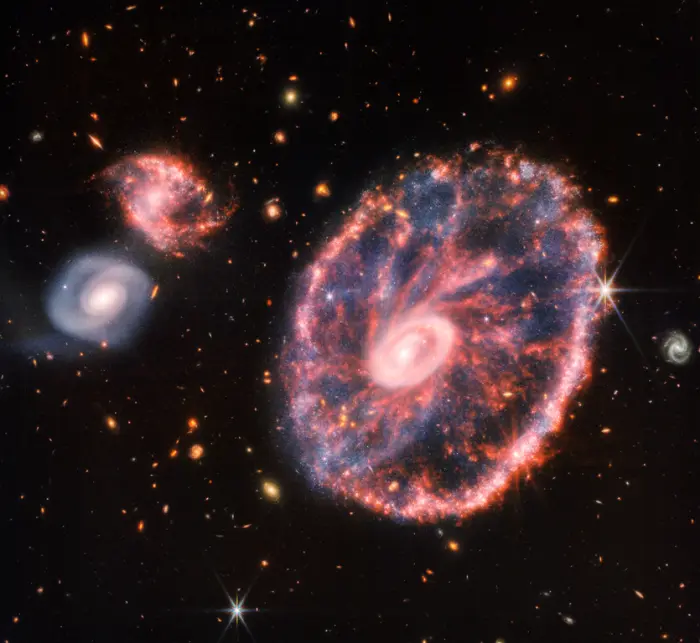
The Cartwheel Galaxy is a ring galaxy located around 500 million light years away in the constellation of Sculptor. This image is a composite of images produced by the James Webb Space Telescope’s NIRCam and MIRI detectors; these images were also released separately. Image credit: NASA, ESA, CSA, STScI
ESO 350-40 contains both optical and non-thermal radio spokes, but they are different structures. They are not associated with each other, and they do not overlap.
The Cartwheel Galaxy’s current structure is expected to last for another few million years. Once the stars, dust and gas that have not escaped the galaxy start to fall back into the galaxy’s centre, the Cartwheel will gradually regain its spiral shape. Only a collision with one of the companion galaxies could prevent this.
The Cartwheel is slightly larger than the Milky Way Galaxy, but smaller than Andromeda. It spans about 150,000 light-years based on a D25 isophotal diameter of 60.9 arcseconds. The span was derived using the redshift-derived distance of 431 million light-years.
The galaxy has an apparent size of 1.1 by 0.9 arcminutes and an apparent magnitude of 15.2. Its outermost ring is 1.5 the size of the Milky Way.
In the past, the Cartwheel Galaxy was a normal spiral galaxy until it collided with a smaller companion galaxy about 200-300 million years ago. When the smaller companion passed through the larger galaxy’s centre, the nearly head-on collision created an enormous shockwave through the Cartwheel.
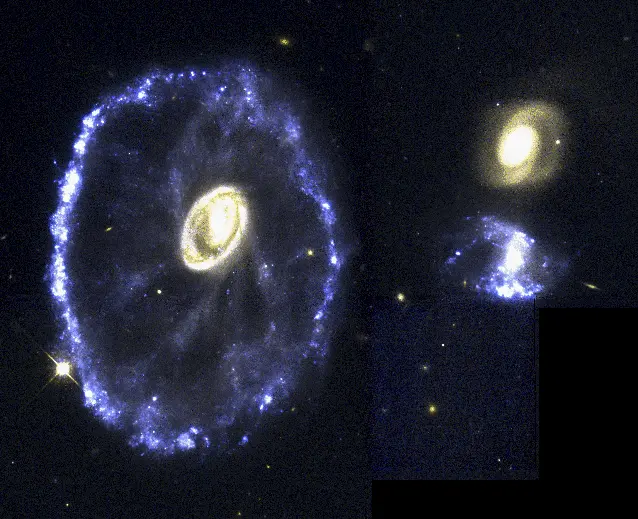
The striking ring-like feature is a direct result of a smaller intruder galaxy — possibly one of two objects to the right of the ring — that careened through the core of the host galaxy. Like a rock tossed into a lake, the collision sent a ripple of energy into space, plowing gas and dust in front of it. Expanding at 200,000 miles per hour, this cosmic tsunami leaves in its wake a firestorm of new star creation. Hubble resolves bright blue knots that are gigantic clusters of newborn stars and immense loops and bubbles blown into space by supernovae. The Cartwheel Galaxy presumably was a normal spiral galaxy like our Milky Way before the collision. This spiral structure is beginning to re-emerge, as seen in the faint arms or spokes between the outer ring and bulls-eye shaped nucleus. The ring contains at least several billion new stars that would not normally have been created in such a short time span and is so large (150,000 light-years across) our entire Milky Way Galaxy would fit inside. Credit: NASA, ESA, and K. Borne (STScI)
The gravitational shockwave expanded through the galaxy at high speed (about 200,000 miles per hour), compressing the dust and gas and triggering star formation in the Cartwheel’s central region. The galaxy’s centre itself was not affected. The starburst region appears as a bright ring around the core.
Starburst galaxies like the Cartwheel contain many exceptionally large and luminous newly formed stars. The Cartwheel Galaxy allows astronomers to study the formation of massive stars in large, fragmented gas clouds. The galaxy’s ring structure is home to several billion new stars, which could not ordinarily have been formed over such a relatively short period.
When massive stars end their lives in supernova events, they leave behind black holes and neutron stars. The neutron stars and black holes that have companion stars pull matter off these stars and become strong X-ray sources. The material pulled from the stars forms accretion discs around them because black holes and neutron stars have enormous gravitational fields. The in-fall of material of the disc creates powerful X-rays. In X-ray images of the galaxy, these X-ray sources appear as white dots along the rim.
The Cartwheel Galaxy is notable for having a large number of X-ray sources identified as black holes in binary systems. About a dozen of such bright X-ray sources have been detected in the galaxy. In most galaxies, astronomers discover only one or two.
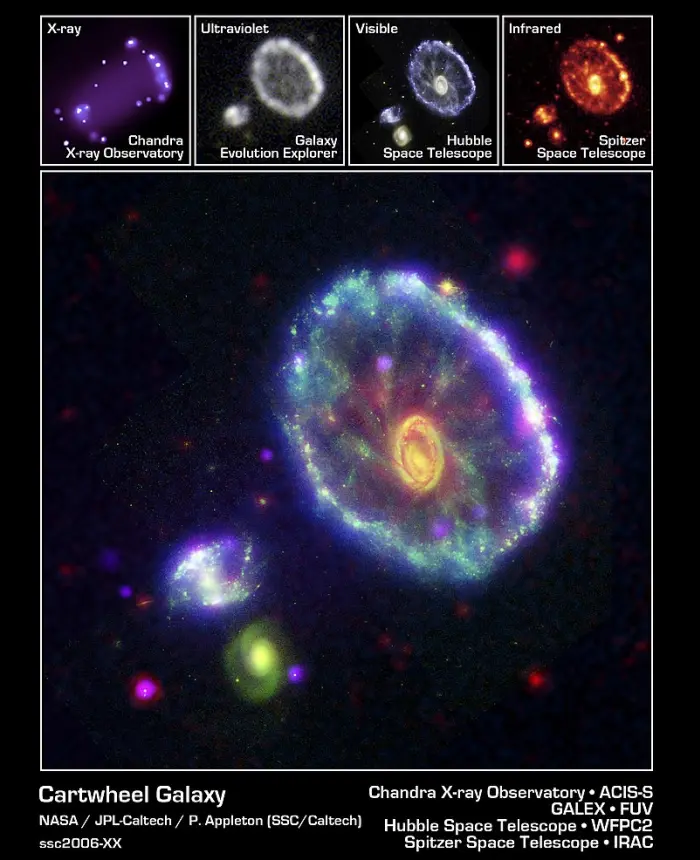
These images of the Cartwheel Galaxy were taken in the X-ray, ultraviolet, visible and infrared bands. Seen at the top left, the Chandra X-ray Observatory’s false color view of the galaxy was taken with the S-array on the telescope’s Advanced CCD Imaging Spectrometer. In the larger composite, Chandra’s X-ray data are also portrayed as purple. The Galaxy Evolution Explorer’s false color view (middle left) was taken with the telescope’s Far Ultraviolet detector. The mission’s contribution to the Cartwheel Galaxy is shown as blue in the larger composite. The Hubble Space Telescope’s (middle right) false color view was taken with the B and I bands of the telescope’s Wide Field and Planetary Camera 2. In the larger composite, only Hubble’s B-band visible light data are shown. The mission’s contribution to the Cartwheel Galaxy in the main image is depicted as green.
The Spitzer Space Telescope’s false color view (top right) of the galaxy was taken at 8.0 microns with the telescope’s Infrared Array Camera. In the larger composite, Spitzer’s infrared observations are also shown as red. Credit: NASA/JPL-Caltech/P. N. Appleton (SSC-Caltech)
Cartwheel Galaxy Group
The Cartwheel Galaxy is the brightest and largest member of a group of four physically related galaxies. The three smaller companions are spiral galaxies referred to as G1, G2, and G3. G1 is an irregular Magellanic spiral, G2 is a compact spiral with a prominent tidal tail, and G3 is a spiral galaxy located at a greater distance, about 287,000 light-years from the Cartwheel Galaxy.
G3 has an HI tail associated with the Cartwheel group and is believed to be the smaller intruder galaxy responsible for creating the Cartwheel Galaxy’s current shape as it passed through the larger galaxy’s disk. The Cartwheel’s current structure is about 300 million years old, and the companions G1 and G2 are still quite close to the galaxy.
Hubble Space Telescope (HST) image
The Cartwheel Galaxy was imaged by the Hubble Space Telescope (HST) in 2007. Hubble was able to resolve details of star birth in the galaxy, giving astronomers an opportunity to study the formation of exceptionally massive stars in large clouds of gas.
The image resolved large clusters of newly formed stars, as well as enormous bubbles sent into space by supernovae. It showed the faint arms connecting the galactic nucleus and the outer ring, indicating that the galaxy’s spiral structure was in the process of reforming.
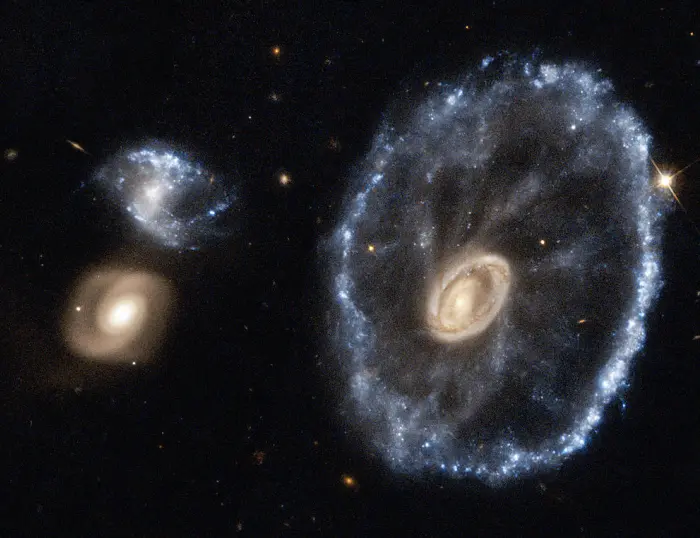
Lying about 500 million light-years away in the constellation of Sculptor, the cartwheel shape of this galaxy is the result of a galactic collision. A smaller galaxy has passed right through a large disc galaxy and produced shock waves that swept up gas and dust — much like the ripples produced when a stone is dropped into a lake — and sparked regions of intense star formation (appearing blue). The outermost ring of the galaxy, which is 1.5 times the size of our Milky Way, marks the shock wave’s leading edge. This object is one of the most dramatic examples of the small class of ring galaxies. Image: ESA/Hubble & NASA
James Webb Space Telescope (JWST) image
The Cartwheel Galaxy was one of the first deep sky objects captured by the James Webb Space Telescope (JWST), along with the Carina Nebula, Stephan’s Quintet, the galaxy cluster SMACS 0723, the spectrum of the exoplanet WASP-96b, and the Southern Ring Nebula. The image of the Cartwheel was released on August 2, 2022.
The James Webb telescope provided new insights into how the galaxy has changed over the course of billions of years, revealing new details about its central black hole and star-forming activity. The image of the Cartwheel was taken with the Near-Infrared Camera (NIRCam) and the Mid-Infrared Instrument (MIRI). It captured a backdrop of many distant galaxies that appear in the same field of view.
Webb’s observations revealed new details about both the galaxy’s nucleus and the outer ring. The images confirmed that the current structure of the galaxy is in a transitory stage. However, what it will transform into is still a mystery. The galaxy has retained the features of a spiral despite the collision, including large rotating spiral arms.
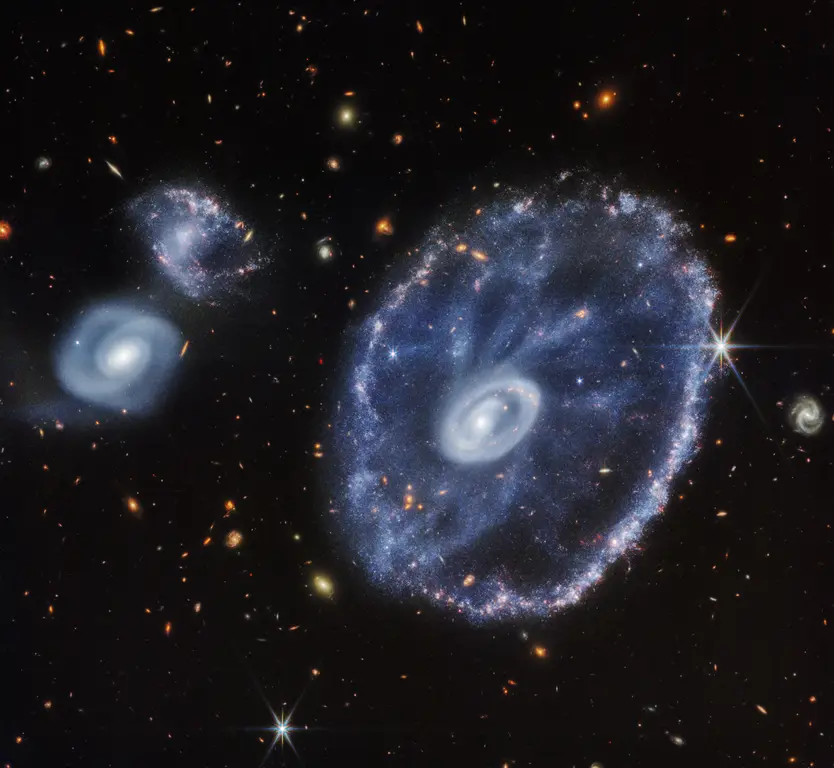
The Cartwheel Galaxy is shown here in the near-infrared, captured by the James Webb Space Telescope’s NIRCam instrument. The telescope has also captured a mid-infrared image as well as a composite of the two images. Credit: NASA, ESA, CSA, STScI
The core of the Cartwheel contains large amounts of hot dust. The James Webb telescope is able to see through the dust and detect infrared light, allowing researchers to examine the galaxy in unprecedented detail.
The brightest regions in the galaxy’s centre host massive clusters of young stars. The outer ring contains starburst regions and supernova remnants. It has been expanding for about 440 million years. As it collides with the surrounding gas and dust, it triggers new star formation.
The NIRCam imager has revealed many more newborn stars in the outer ring. Many of these stars are still shrouded in their parent clouds and obscured by dust when observed in visible light. However, they are not hidden from Webb’s near-infrared vision.
The camera has captured both individual stars and star-forming regions, which show up as blue dots in the image. The image allows astronomers to distinguish between the shape and distribution of older populations of stars in the galaxy’s central region and the clumpy shapes of the younger stars and star clusters outside the core.
The MIRI instrument has provided new insights into the dust within the galaxy. It revealed silicate dust and areas rich in hydrocarbons and other compounds. These areas are part of the spiralling spokes previously imaged by Hubble, which can be seen more clearly in the James Webb image.
The young stars in the outer ring energize the hydrocarbon dust, making it appear orange in the MIRI image. The dust that forms the spokes between the galaxy’s centre and the outer ring is predominantly silicate dust.
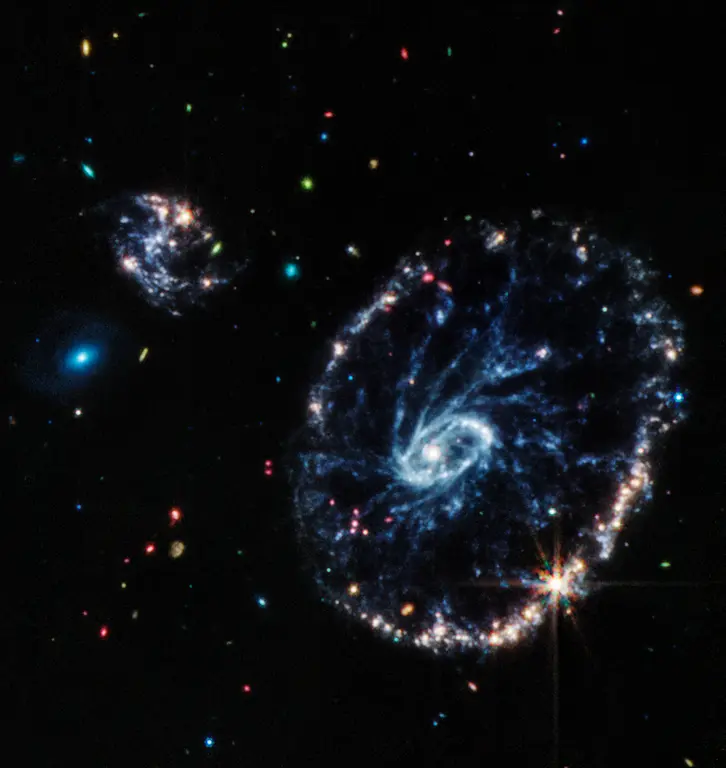
The Cartwheel Galaxy is shown here in the mid-infrared, captured by the James Webb Space Telescope’s MIRI instrument. The telescope has also captured a near-infrared image as well as a composite of the two images. Image credit: NASA, ESA, CSA, STScI
The smaller companion spiral galaxy appearing to the upper left of the Cartwheel in the JWST images shares many similarities with its larger neighbour. It hosts a lot of star formation and has similar streaks of glowing hydrocarbon-rich dust with bright blue dots. The blue dots are individual stars and star-forming regions.
Facts
The Cartwheel Galaxy was discovered by Swiss astronomer Fritz Zwicky at the California Institute of Technology (Caltech) in 1941. Zwicky considered the galaxy to be “one of the most complicated structures awaiting its explanation on the basis of stellar dynamics.”
A type II supernova was detected in the galaxy on November 23, 2021. It was designated SN 2021afdx. It was located 18’’.3 east and 26’’.5 south of the galaxy’s centre. The supernova was captured in the James Webb image.
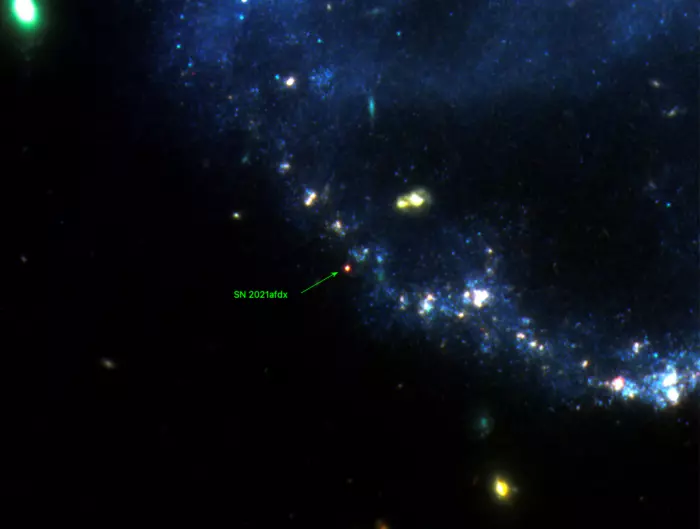
The supernova SN 2021afdx in the Cartwheel Galaxy, image: NASA, ESA, CSA, STScI
The Cartwheel Galaxy rotates at the speed of 217 km/s at the outer ring. It is receding from us at 9,050 km/s. It has an estimated mass of between 2.9 and 4.8 billion solar masses.
The Cartwheel Galaxy is one of the brightest sources of ultraviolet emission in the local universe.
As a result of the collision with the smaller galaxy, there are older stars in the Cartwheel Galaxy’s inner region, seen in ultraviolet wavelengths.
The images of the Cartwheel Galaxies reveal many faint, more distant galaxies, which form a large superstructure and lie near the Sculptor Wall, an enormous structure of galaxy clusters that extends outwards for more than a billion light years.
There is an alternative theory, the Ball-of-Light Particle Model, that may explain the galaxy’s unusual appearance. The model suggests that the large ball-of-light that originally made up the galaxy’s core eventually became unstable and split into two or three. At least one of these expelled balls-of-light became one of the smaller galaxies seen next to the Cartwheel. This would explain the bridge of material, a trail of neutral hydrogen gas, connecting the Cartwheel Galaxy and ones of the smaller galaxies nearby.
What was left of the core was highly unstable and a large electromagnetic field spun around it, inducing massive stars and expelling them in a ring pattern at high speed. The high velocity kept the ejected stars stable as it induced large gravitational forces within their cores. The surface of the Cartwheel’s core eventually started to become more stable, continuing to expel stars, which have become the ‘spokes’ seen in the galaxy.
The Cartwheel’s core later became unstable again and expelled another ring. This inner ring contains large balls-of-light that are decaying and leaving trails of smaller balls-of-light that create large structures with shapes similar to comets.
Location
The Cartwheel Galaxy is located in the constellation Sculptor, near the red giant Eta Sculptoris (mag. 4.8). The galaxy lies about two-thirds of the way from the brighter Diphda in Cetus to Ankaa in Phoenix. It appears in the same region of the sky as the brighter spiral galaxies NGC 300 and NGC 55 (the Whale Galaxy). With an apparent magnitude of 15.2, it is best observed in 10-inch and larger telescopes.
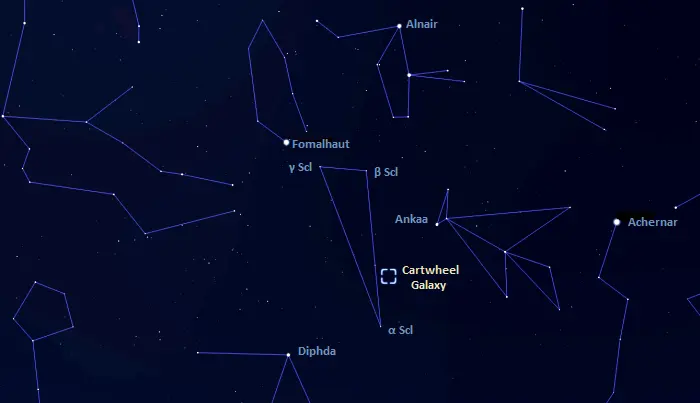
The location of the Cartwheel Galaxy in Sculptor, image: Stellarium
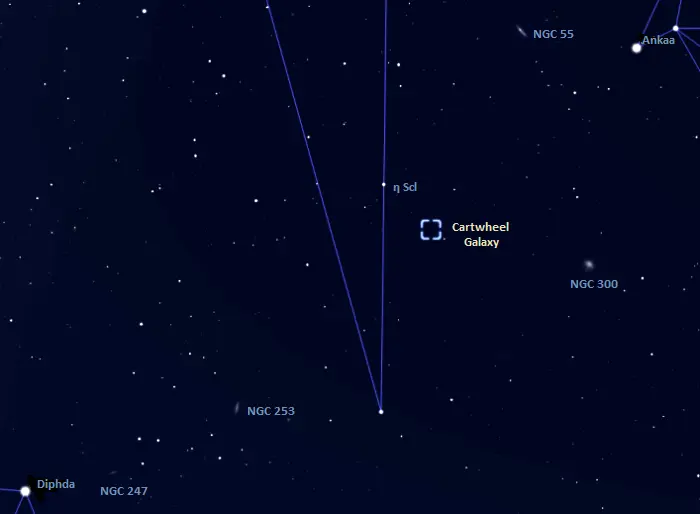
The location of the Cartwheel Galaxy near Eta Sculptoris, image: Stellarium
The constellation Sculptor lies in the southern sky and can be a challenging target for northern observers. The entire constellation is visible from locations south of the latitude 50° N. The best time of the year to observe its stars and deep sky objects is during the month of November, when it rises high above the horizon in the evening sky.
Cartwheel Galaxy – ESO 350-40
| Constellation | Sculptor |
| Right ascension | 00h 37m 41.1133192382s |
| Declination | −33° 42′ 58.515101737″ |
| Type | S pec (Ring) |
| Apparent magnitude | 15.2 |
| Apparent size | 1′.1 x 0′.9 |
| Size | 144,300 light-years (44.23 kiloparsecs – isophotal diameter) |
| Mass | 2.9 – 4.8 billion solar masses |
| Distance | 500 million light-years (150 megaparsecs) |
| Redshift | 9,050 ± 3 km/s |
| Names and designations | Cartwheel Galaxy, Cartwheel Ring Galaxy, Zwicky’s Ellipse, PGC 2248, LEDA 2248, VV 784, ESO 350-40, MCG-06-02-022a, SGC 003515-3359.5, AM 0035-335, FM 351-2, HRG 35002 |